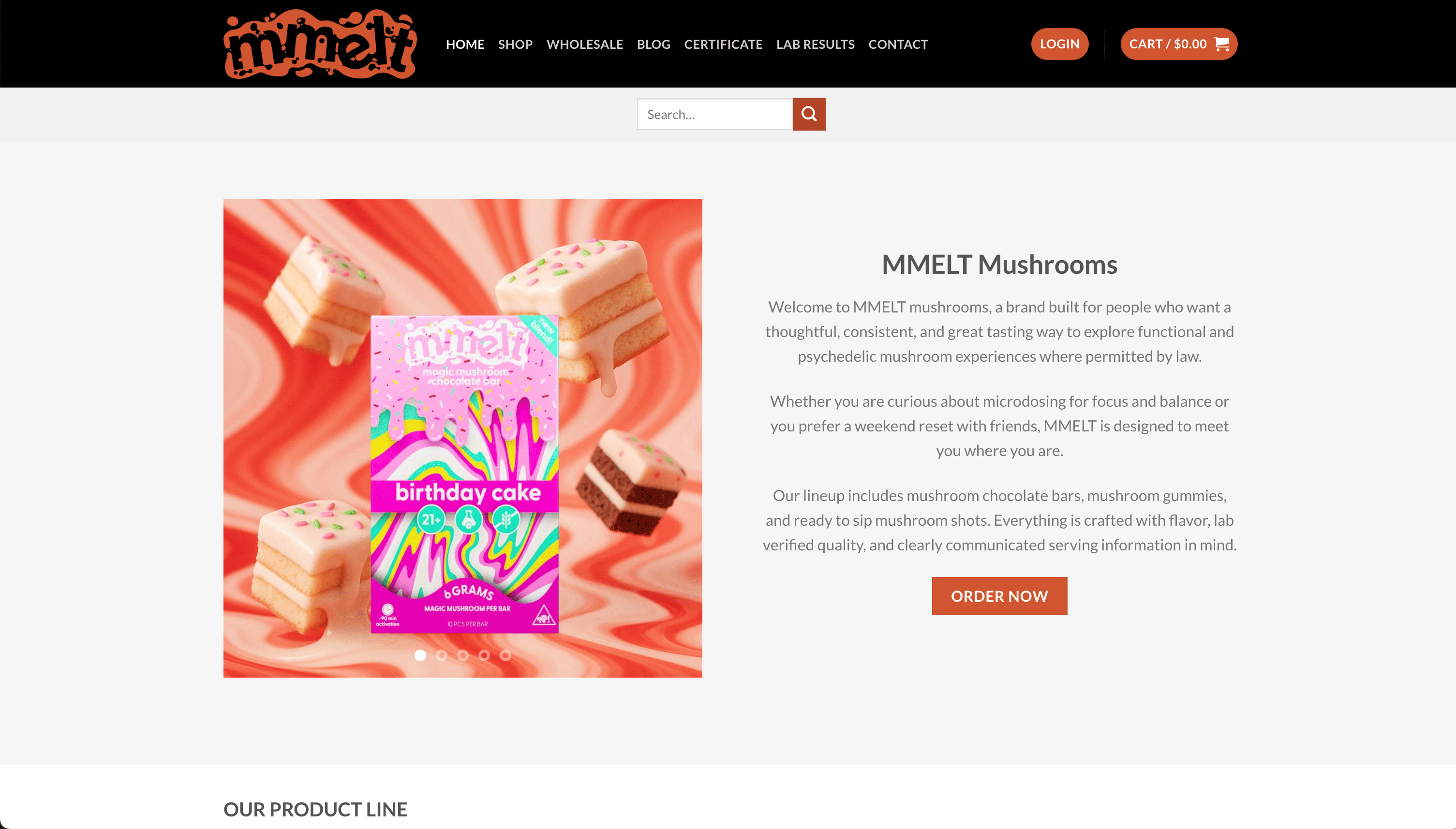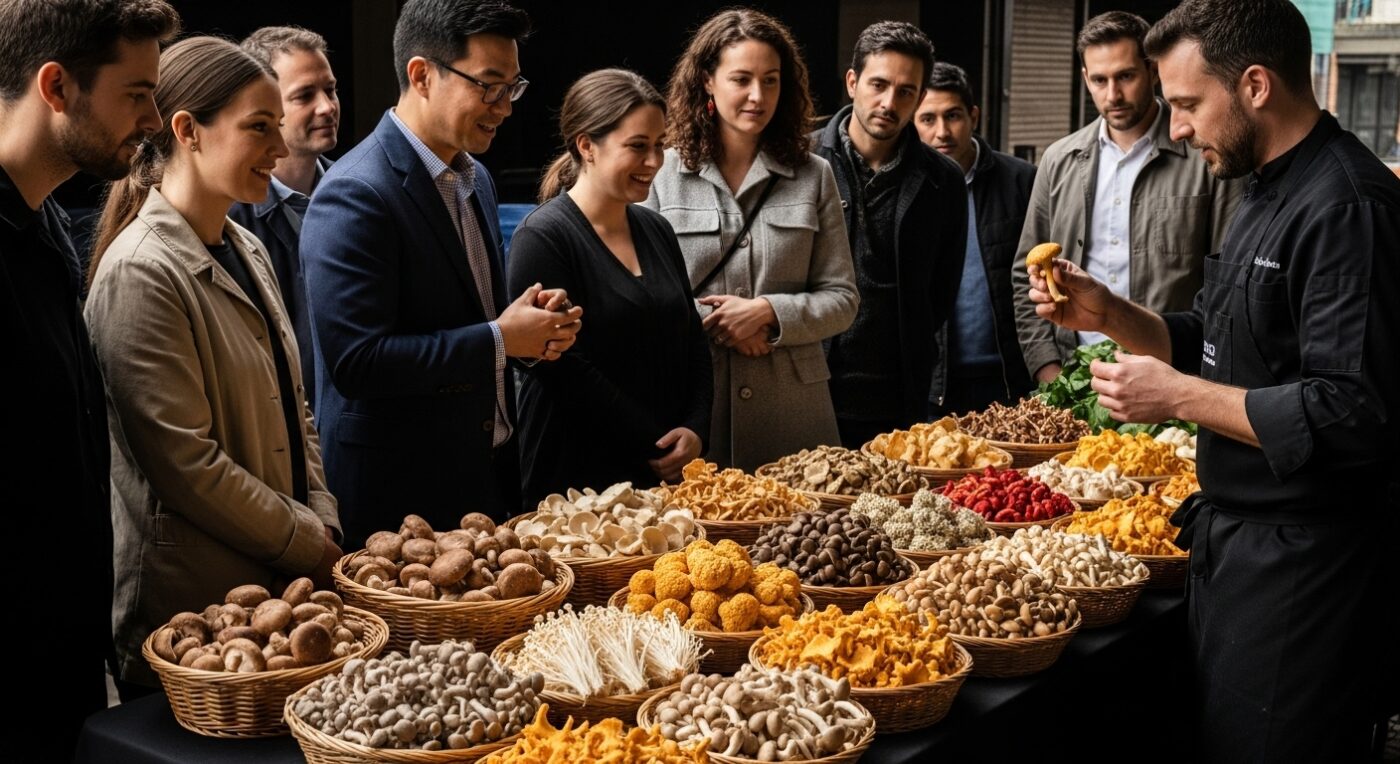Blog
8 Delicious Examples of Mushroom Edibles to Try
Edible mushrooms have been enjoyed for thousands of years and are prized for their deep flavors and powerful nutrition. But most people have no idea that some species pack more protein per calorie than most vegetables and are the only non-animal food naturally containing vitamin D. What really sets them apart goes beyond taste or health stats. The world of edible mushrooms hides a complexity that not only changes how we eat but how we think about food itself.
Table of Contents
- Introduction To Edible Mushrooms
- Common Culinary Mushrooms
- Medicinal Mushrooms
- Mushrooms For Nutritional Boost
- Unique And Exotic Mushroom Varieties
- How To Prepare Mushroom Edibles
- Safety Tips For Foraging Mushrooms
- Where To Buy Quality Mushroom Edibles
Quick Summary
| Takeaway | Explanation |
|---|---|
| Edible mushrooms are nutritious | They are rich in protein, fiber, vitamins, and low in calories, making them an excellent dietary choice. |
| Sourcing and preparation are crucial | Proper handling and cooking techniques maximize mushroom flavor and health benefits; always prioritize quality. |
| Medicinal mushrooms offer health benefits | Certain types like Reishi and Lion’s Mane can potentially support immune function and cognitive health. |
| Foraging requires expert knowledge | Misidentification of mushrooms can be dangerous; never consume wild mushrooms without expert verification. |
| Buying quality products is essential | Look for transparency in sourcing, lab testing, and manufacturer reputation to ensure safe and effective mushroom edibles. |
1: Introduction to Edible Mushrooms
Edible mushrooms represent a fascinating world of culinary and functional nutrition, offering an extraordinary range of flavors, textures, and potential health benefits. These remarkable fungi are far more than simple ingredients – they are complex organisms with profound nutritional profiles that have been utilized by human cultures for thousands of years.
From ancient traditional medicine to modern gourmet cuisine, mushrooms have consistently demonstrated their versatility and significance. The world of edible mushrooms encompasses numerous species, each with unique characteristics and potential applications. Discover our comprehensive guide on mushroom edible identification to understand the nuanced world of these incredible organisms.
Key characteristics of edible mushrooms include:
- Rich in essential nutrients like protein, fiber, and vitamins
- Potential immune system support
- Low in calories
- Contains unique bioactive compounds
According to research from the National Institutes of Health, edible mushrooms are recognized as functional foods with significant nutritional value. These organisms contain complex compounds that may offer potential health benefits beyond basic nutrition.
When exploring mushroom edibles, consumers should prioritize understanding sourcing, preparation methods, and potential interactions with individual health conditions. Responsible consumption and informed selection are crucial for maximizing the potential benefits of these remarkable natural products.
2: Common Culinary Mushrooms
Culinary mushrooms represent a diverse and delectable world of flavors, textures, and nutritional profiles that have transformed global cuisine. Different mushroom varieties offer unique characteristics that make them essential ingredients in kitchens worldwide. Explore our comprehensive guide on functional mushroom types to understand the incredible diversity of these remarkable organisms.
According to Harvard T.H. Chan School of Public Health, several mushroom varieties stand out for their culinary and nutritional significance:
- White Button Mushrooms: Mild flavor, versatile in cooking
- Cremini Mushrooms: Slightly deeper flavor than white buttons
- Portobello Mushrooms: Large, meaty texture perfect for grilling
- Shiitake Mushrooms: Rich, umami flavor popular in Asian cuisine
- Oyster Mushrooms: Delicate texture with subtle flavor
These mushrooms are not just flavorful but also packed with essential nutrients. They provide protein, fiber, potassium, and various B vitamins while remaining low in calories. Their versatility allows them to be used in numerous culinary applications, from salads and stir-fries to sophisticated gourmet dishes.
Cooking techniques significantly impact mushroom flavor and texture. Sautéing, roasting, grilling, and even consuming them raw can produce dramatically different taste experiences. Understanding each mushroom’s unique characteristics helps home cooks and professional chefs maximize their potential in creating memorable dishes.
3: Medicinal Mushrooms
Medicinal mushrooms have been utilized for centuries in traditional healing practices, representing a powerful intersection between natural wellness and scientific research. Modern science increasingly validates the remarkable health potential of these extraordinary fungi. Learn more about top wellness mushrooms to understand their comprehensive benefits.
According to a groundbreaking clinical study, certain mushrooms demonstrate significant therapeutic potential across multiple health domains. These powerful organisms contain complex bioactive compounds that can support various bodily functions.
Key medicinal mushrooms with notable health benefits include:
- Reishi: Supports immune system and stress reduction
- Lion’s Mane: Potential cognitive and neurological support
- Chaga: High in antioxidants and potential anti-inflammatory properties
- Cordyceps: May enhance athletic performance and energy levels
- Shiitake: Supports cardiovascular and immune system health
The biochemical complexity of medicinal mushrooms sets them apart from traditional supplements. They contain unique compounds like beta-glucans, triterpenes, and polysaccharides that interact with human biological systems in sophisticated ways. While promising, consumers should approach medicinal mushrooms with informed understanding, consulting healthcare professionals and selecting high-quality, responsibly sourced products.
Research continues to uncover the intricate mechanisms by which these remarkable fungi potentially contribute to human health, offering exciting prospects for integrative wellness strategies.
4: Mushrooms for Nutritional Boost
Mushrooms represent an extraordinary nutritional powerhouse that can dramatically enhance dietary wellness. Nutrient-dense and versatile, these fungi offer a remarkable range of health-supporting compounds that make them far more than simple food ingredients. Check out our essential wellness tips for mushroom consumption to maximize their potential benefits.
According to the Mushroom Council, mushrooms provide exceptional nutritional value with unique characteristics that set them apart from other food groups. They are extraordinarily low in calories while being rich in essential nutrients and bioactive compounds.
Key nutritional highlights of mushrooms include:
- Vitamin D source: Only non-animal food naturally containing vitamin D
- Low-calorie: Typically under 20 calories per serving
- High in B vitamins: Especially riboflavin and niacin
- Mineral-rich: Contains selenium, potassium, and copper
- Protein content: Higher protein levels compared to most vegetables
The biochemical complexity of mushrooms makes them exceptional dietary supplements. They contain unique polysaccharides that act as prebiotics, supporting gut health by stimulating beneficial bacteria growth. Their combination of vitamins, minerals, and bioactive compounds provides comprehensive nutritional support that can complement various dietary approaches.
For individuals seeking natural, nutrient-rich food options, mushrooms offer an unparalleled combination of flavor, versatility, and health-supporting properties. Integrating these remarkable fungi into regular dietary patterns can contribute to overall nutritional wellness.
5: Unique and Exotic Mushroom Varieties
Exotic mushroom varieties represent a fascinating culinary frontier, offering adventurous food enthusiasts extraordinary flavors and textures beyond traditional mushroom types. Learn more about unique mushroom experiences to explore these remarkable fungi.
According to the University of Illinois Extension, several unique mushroom varieties stand out for their distinctive characteristics and remarkable culinary potential.
Exotic mushroom varieties that challenge traditional palates include:
- Lion’s Mane: Seafood-like texture resembling crab or lobster meat
- Blue Oyster: Delicate flavor with striking blue-gray coloration
- Pink Oyster: Vibrant pink hue with a mild, woody taste
- Cauliflower Mushroom: Intricate, brain-like appearance with subtle nutty flavor
- King Oyster: Meaty texture perfect for grilling and roasting
Cultivation techniques have expanded the accessibility of these extraordinary fungi. Modern mushroom farms now specialize in producing rare varieties that were once challenging to source. The unique textures and flavors of these exotic mushrooms make them prized ingredients among innovative chefs and adventurous home cooks.
These remarkable fungi not only provide exceptional taste experiences but also offer diverse nutritional profiles that set them apart from more common mushroom varieties. Exploring exotic mushrooms represents a culinary adventure that challenges traditional understanding of flavor, texture, and nutritional potential.
6: How to Prepare Mushroom Edibles
Preparing mushroom edibles requires careful attention to technique, quality, and safety. Explore our comprehensive guide on mushroom edible best practices to ensure optimal preparation and consumption.
According to the University of Minnesota Extension, selecting and preparing high-quality mushrooms involves several critical steps. Proper handling is essential to maintain flavor, texture, and nutritional integrity.
Key preparation guidelines for mushroom edibles include:
- Select firm, smooth mushrooms with no visible blemishes
- Rinse gently under cool running water
- Pat dry with clean paper towels
- Trim tough stems or remove completely for certain varieties
- Store properly in refrigerator for maximum freshness
Cooking techniques dramatically influence mushroom flavor and texture. Different methods like sautéing, roasting, grilling, and steaming can transform the same mushroom variety into completely distinct culinary experiences. Experienced chefs recommend gentle heat and minimal liquid to preserve the mushrooms’ natural essence.
Consumers should always source mushrooms from reputable suppliers, ensuring they are consuming safe, professionally cultivated varieties. While some mushrooms can be enjoyed raw, many benefit from light cooking that enhances their natural flavors and makes them more digestible. Understanding each mushroom’s unique characteristics helps create delicious, nutritious edible experiences.
7: Safety Tips for Foraging Mushrooms
Mushroom foraging demands extreme caution and expert knowledge to prevent potentially life-threatening mistakes. Learn essential steps for safe mushroom consumption to protect yourself from dangerous encounters with toxic species.
Foraging requires comprehensive understanding and meticulous attention to detail. Misidentification can lead to severe health risks, including potential organ damage or fatal poisoning. Professional mycologists emphasize that even experienced foragers can mistake deadly mushrooms for edible varieties.
Critical safety considerations for mushroom foraging include:
- Never consume wild mushrooms without expert verification
- Photograph mushrooms from multiple angles for precise identification
- Carry identification guides specific to your regional ecosystem
- Learn from certified mycological experts
- Understand that visual similarities can be extremely deceptive
According to the North American Mycological Association, approximately 10,000 known mushroom species exist, with roughly 50-100 considered seriously toxic. Toxic mushrooms can closely resemble edible varieties, making visual identification exceptionally challenging for untrained individuals.
Professional foragers recommend multiple verification steps, including spore print analysis, microscopic examination, and consultation with regional mushroom identification experts. Novice foragers should always prioritize safety by purchasing mushrooms from verified sources rather than risking dangerous self-identification attempts.
8: Where to Buy Quality Mushroom Edibles
Purchasing high-quality mushroom edibles requires careful consideration and informed decision-making. Learn how to select the best mushroom edibles to ensure you receive safe, effective products.
According to the National Center for Biotechnology Information, quality control is paramount when selecting mushroom edibles. Consumers must prioritize transparency and scientific verification in their purchasing decisions.
Key factors to consider when buying mushroom edibles include:
- Third-party lab testing results
- Clear ingredient labeling
- Transparent sourcing information
- Reputation of the manufacturer
- Specific extraction and processing methods
Discerning buyers should investigate the source and production process of their mushroom edibles. Reputable suppliers will provide comprehensive information about cultivation, harvesting, and processing techniques. This transparency helps consumers understand the quality and potential benefits of the products they are purchasing.
Online platforms, specialized health food stores, and direct-to-consumer mushroom brands offer diverse options for purchasing mushroom edibles. However, consumers must remain vigilant, researching product origins, reading customer reviews, and verifying the credibility of the manufacturer before making a purchase. The most reliable sources provide detailed information about their products, including comprehensive lab testing results and clear explanations of their production methods.
Below is a comprehensive table summarizing the key topics, benefits, and action points discussed throughout the article on mushroom edibles.
| Section/Topic | Key Points & Insights | Benefits/Actions |
|---|---|---|
| Edible Mushrooms Overview | Mushrooms are nutrient-rich, offer unique bioactive compounds, and have a long history in cuisine and traditional medicine. | Boost nutrition, explore culinary and health uses |
| Common Culinary Types | Includes white button, cremini, portobello, shiitake, oyster; each has distinct flavor, texture, and cooking applications. | Versatile cooking, enhances taste and nutrition |
| Medicinal Mushrooms | Varieties like Reishi, Lion’s Mane, Chaga, Cordyceps have researched immune, cognitive, and health-supporting properties. | Potential health/wellness improvements with evidence support |
| Nutritional Benefits | Only non-animal vitamin D source, high in B vitamins, minerals, fiber, and protein compared to most vegetables, low in calories. | Natural nutrient boost, dietary supplementation |
| Unique/Exotic Varieties | Exotic types like Lion’s Mane, Blue Oyster offer novel flavors, textures, and nutritional diversity for adventurous consumers. | Try new culinary experiences, expand taste profiles |
| Safe Preparation Methods | Choose fresh, blemish-free mushrooms; rinse gently; trim stems; store and cook properly (sauté, roast, grill, steam). | Ensure best flavor, nutrition, and safe consumption |
| Foraging Safety Guidance | Never eat wild mushrooms without expert ID; use local guides; get verification; misidentification risks severe poisoning. | Avoid toxicity—always prioritize safety and expert input |
| Buying Quality Edibles | Seek lab-tested, transparent, reputable sources; check labeling and manufacturer information; research product origins. | Safe, reliable mushroom edibles with validated quality |
Experience Mushroom Edibles With Lab-Tested Confidence
You just explored eight delicious examples of mushroom edibles and learned how quality, safety, and clarity are your top priorities. Whether you want rich chocolate, tasty gummies, or convenient shots, the biggest challenges revolve around finding products that are genuinely safe, properly dosed, and transparently sourced. Many readers worry about unknown origins, hidden ingredients, and lack of reliable guidance. At MMELT Mushrooms, we solve these issues with industry-leading lab verification, clear ingredient information, and detailed product education rooted in the same responsible practices highlighted in your article.

Transform your mushroom experience with real proof and delicious variety. Explore a curated collection of lab-tested mushroom-infused edibles including chocolates, gummies, and microdose shots. We offer trusted results and educational support with every product. See the difference for yourself by visiting MMELT Mushrooms. Want to learn how to select safe, high-quality edibles? Start with our guide on how to select mushroom edibles or check out tips for mushroom edible best practices. Discover better, shop smarter, and take the next step toward dependable and enjoyable mushroom wellness today.
Frequently Asked Questions
What are the health benefits of eating edible mushrooms?
Edible mushrooms are rich in essential nutrients such as protein, fiber, and various vitamins. They may also support the immune system and contain unique bioactive compounds that offer additional health benefits beyond basic nutrition.
How should I prepare edible mushrooms for cooking?
When preparing edible mushrooms, select firm and smooth specimens, rinse them gently under cool water, pat them dry, and trim any tough stems. Cooking techniques like sautéing, roasting, or grilling can enhance their flavor and texture.
Are all mushrooms safe to eat?
No, not all mushrooms are safe to eat. It’s critical to avoid consuming wild mushrooms without expert verification, as some species are toxic and can resemble edible ones. Always consult identification guides and seek expertise before foraging.
What makes exotic mushrooms unique compared to common varieties?
Exotic mushrooms often have distinctive flavors and textures that set them apart from more common types. For example, varieties like Lion’s Mane or Blue Oyster have unique culinary characteristics and can elevate dishes with their unique tastes.
Recommended
- Mushroom Edible Education Guide: Safely Identify Edibles – MMELT
- Understanding Mushroom Edibles vs Dry Mushrooms – MMELT
- Blog – MMELT
- Blog Archives – MMELT

